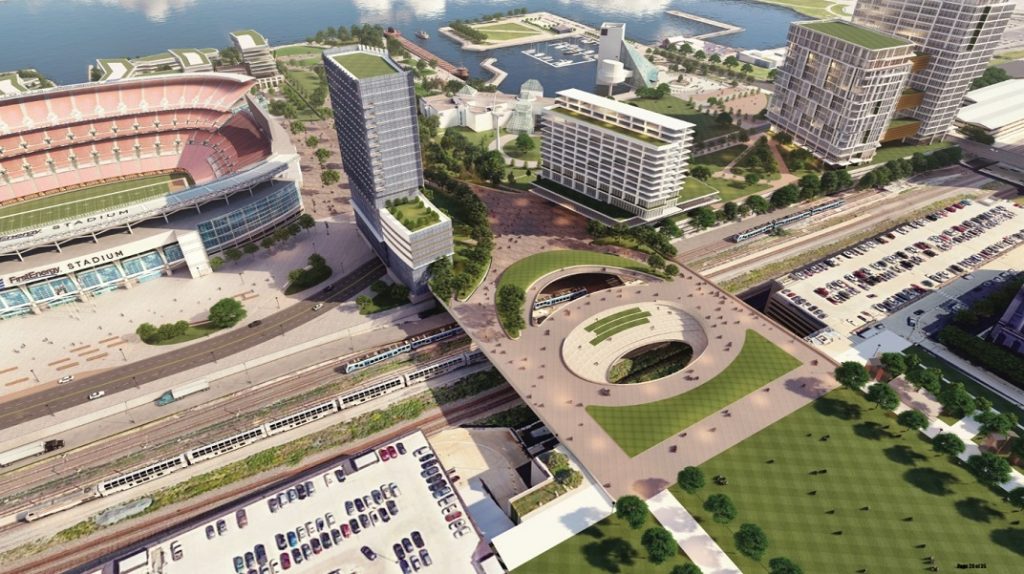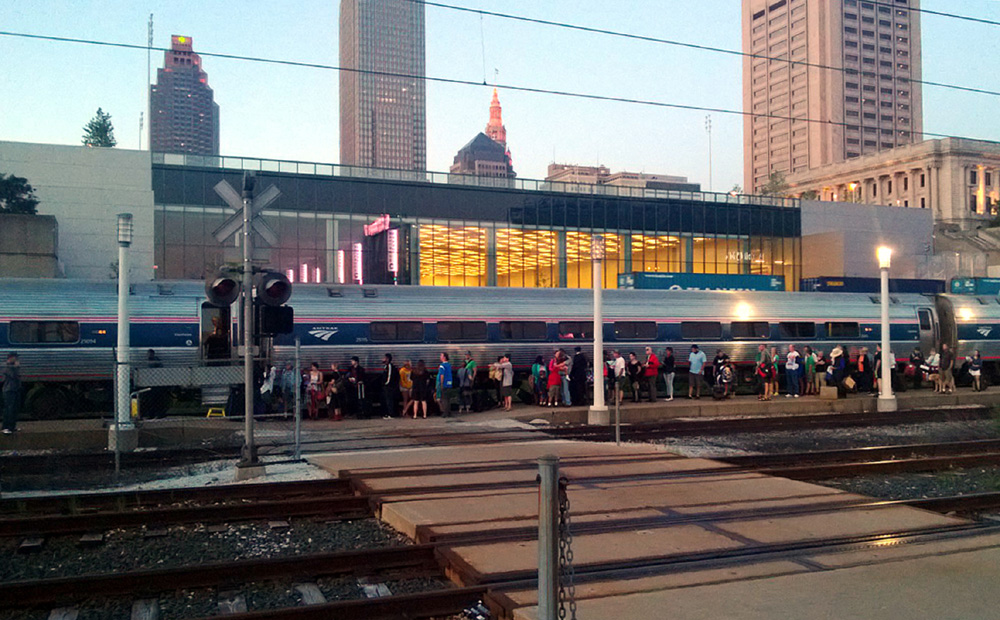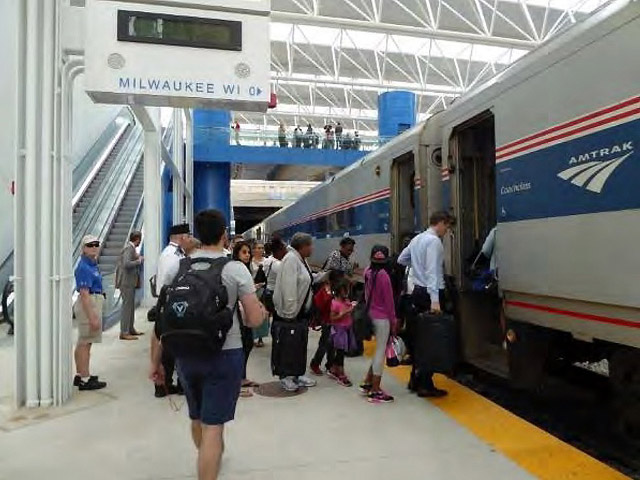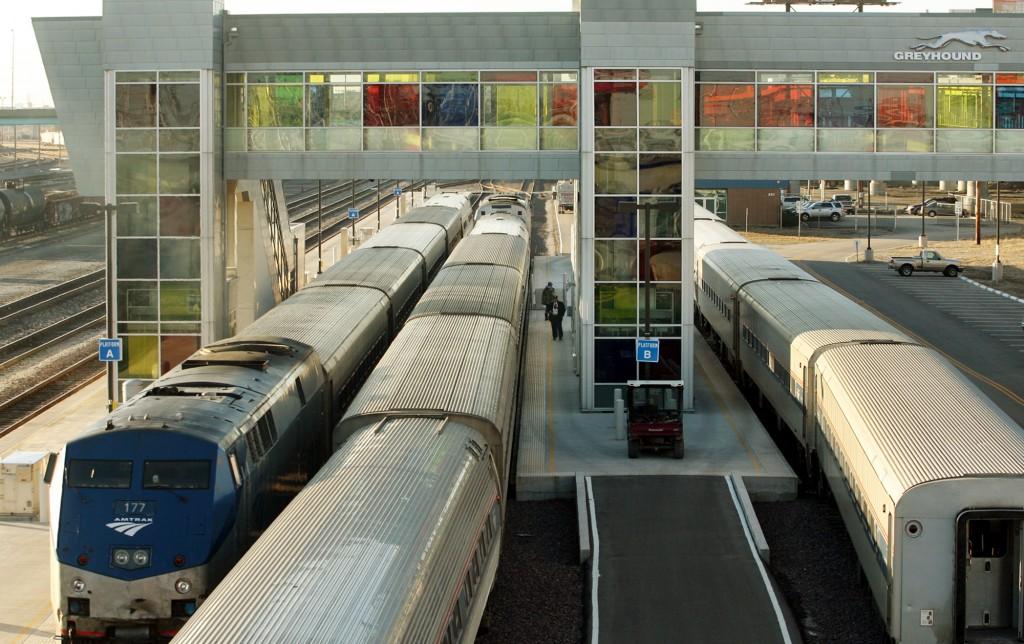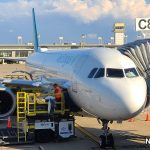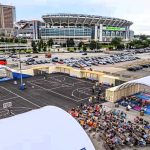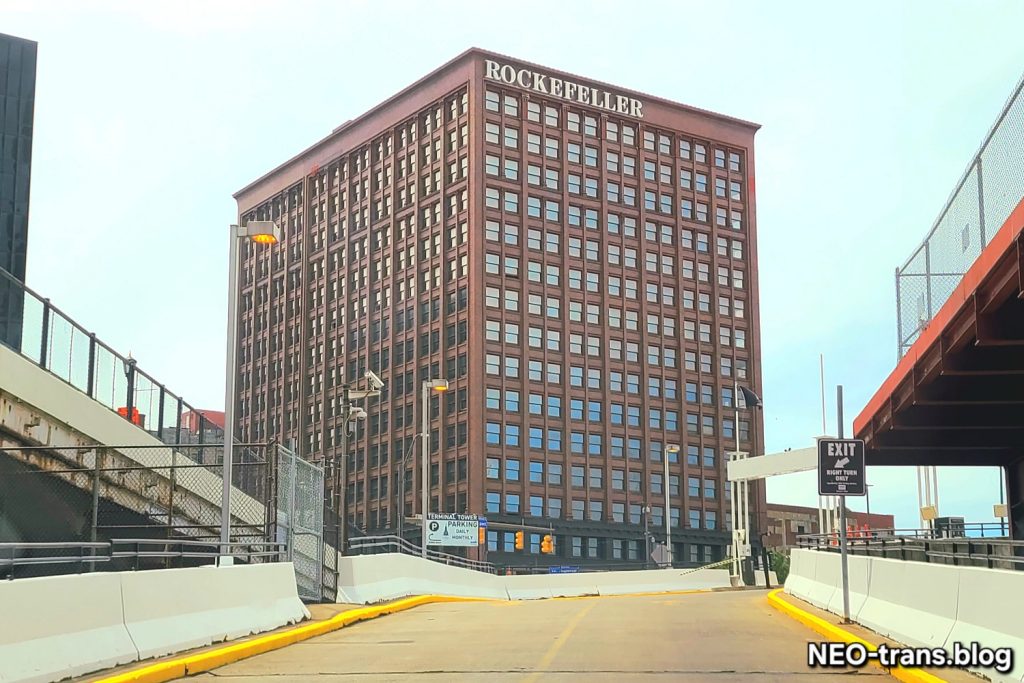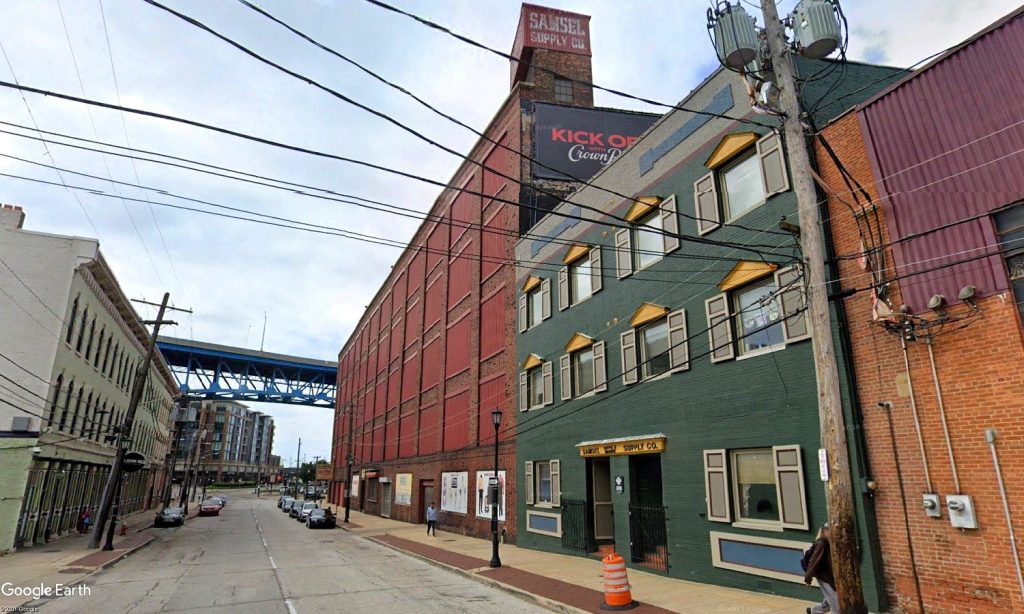A multi-modal transportation center including Amtrak trains and Regional Transit Authority light-rail is part of downtown Cleveland lakefront development planned by the city, Cleveland Browns owners the Haslam Sports Group, and the Northeast Ohio Areawide Coordinating Agency. The latter said it intends to ask the federal government to help fund making Cleveland an Amtrak mini-hub (AoDK). CLICK IMAGES TO ENLARGE THEM
While ODOT studies, MPO speaks up for rail
The director of the Northeast Ohio Areawide Coordinating Agency (NOACA), a metropolitan planning organization, today said she intends to submit to the Federal Railroad Administration (FRA) multiple proposed passenger rail routes through Cleveland for inclusion in the Biden Administration’s multi-billion-dollar rail development program. There was a new FRA program announced today to which NOACA pledged to submit Cleveland-based routes for consideration.
In addition to the four existing Chicago-East Coast trains that stop in Cleveland each night, Amtrak proposes to add short-distance, multiple daily passenger trains to Columbus, Cincinnati, Pittsburgh, Detroit and Buffalo as part of its Amtrak Connects US plan. NOACA Executive Director Grace Gallucci told NEOtrans today that she intends to speak up now to say that Greater Cleveland is interested in all those proposals.
“Yes we will be submitting the ones in the Amtrak Midwest plan,” said Gallucci in an e-mail. She specifically referred to short-distance routes linking Cleveland to Detroit, Pittsburgh and Buffalo, plus expansion of long-distance Chicago – Cleveland – East Coast routes to New York City, Philadelphia and Washington DC.
Meanwhile, at the request of Gov. Mike DeWine, the Ohio Department of Transportation (ODOT) and its Ohio Rail Development Commission (ORDC) are again studying whether passenger rail, including the 3C+D Corridor linking Cleveland, Columbus, Dayton and Cincinnati, is feasible for the nation’s seventh-most populous state.
Combined, all of the planned expansions would turn Cleveland into a mini-hub for Amtrak by bringing two dozen daily trains and up to 1 million annual riders to downtown Cleveland each day. That compares to other mini-hubs for Amtrak including Seattle, Portland, OR; Albany, NY; Harrisburg, PA; Milwaukee and St. Louis.
Today, the FRA issued rules for submitting passenger rail routes for consideration in the federal passenger rail Corridor Identification and Development Program. But the FRA’s notice is more than just setting the ground rules for the program. It also serves as a request for expressions of interest to be submitted to the FRA.
“Americans deserve what people in many other countries currently benefit from: a world-class rail system that allows you to get where you need to go quickly and affordably, while reducing traffic and pollution on our roads,” said U.S. Transportation Secretary Pete Buttigieg. “In launching the Corridor Identification and Development program, which was made possible thanks to President Biden’s Bipartisan Infrastructure Law, we are taking a major step to transform America’s passenger rail network and connect our smallest towns and our biggest cities with great train service.”
As part of $66 billion in passenger rail funding, the new infrastructure law has $1.8 billion for the Corridor ID program which must be established within 180 days. The program gives public entities, including states and metropolitan planning organizations, a formal mechanism to partner with FRA to develop proposals that will expand, enhance, or restore passenger rail service in their communities. Within a year, FRA will submit an annual report to Congress on the program as well as the routes and projects it will support.
Passengers in downtown Milwaukee board a state-supported Amtrak train to Chicago at the city’s intermodal transportation center that combines Amtrak passenger trains, local and intercity buses plus The Hop streetcar. Wisconsin is joining with Minnesota and Illinois to fund expanded Twin Cities-Milwaukee-Chicago Amtrak service to increase travel choices and access to jobs, health care, universities and tourism (MIPRC).
The FRA notice says eligible routes include a new or enhanced intercity passenger rail route of less than 750 miles that would have to be state-supported, restoration of service over all or portions of an intercity passenger rail route formerly
operated by Amtrak, and the increase of service frequency of a long-distance intercity passenger rail route. Among the existing and proposed services to Cleveland, all would be eligible.
“The Corridor ID program will help expand intercity passenger rail service beyond the Northeast Corridor,” FRA Administrator Amit Bose said. “This is just one of many ways the Bipartisan Infrastructure Law is bringing about the next great rail revolution.”
Earlier this week, in response to a question from Columbus Underground, a spokesperson from Gov. Mike DeWine’s office said “The Governor has asked the Ohio Rail Development Commission (ORDC) to engage with Amtrak to determine the feasibility and cost of the routes identified in the Amtrak ‘Connects US’ proposal. The feasibility determination is still in process.”
“ORDC staff met with Amtrak officials to learn their perspective on funding opportunities for passenger rail development,” said ORDC Public Information Officer Wende Jourdan in an e-mail to NEOtrans. “Amtrak confirmed that all the development opportunities are through the federal government. The Federal Railroad Administration is releasing corridor development program guidance which will provide a better understanding of the requirements or responsibilities of the state for any passenger rail development.”
A feasibility study differs from developing a plan whose goal is to apply for federal construction and operating funds. NOACA and other regional planning agencies from Cleveland to Chicago, with Amtrak’s support, are seeking the latter.
At certain times of the day, the St. Louis Gateway Transportation Center can be busy with Amtrak trains including those bound for Chicago at 110 mph thanks to the state of Illinois sponsoring infrastructure improvements. This station is also served by Greyhound buses and MetroLink light-rail allowing improved mobility with easy connections among local, regional and intercity transportation modes (StlToday).
They want $2.56 million in federal planning funds to see what infrastructure improvements are needed to add daytime Amtrak trains to the Windy City and ease freight train congestion. NOACA expects to hear from the FRA by this summer on whether it will receive those funds. That action-oriented approach, including requesting the inclusion of Cleveland-based routes in the FRA’s Corridor ID Program, was enthusiastically received by rail advocates.
“I am so pleased to hear what Grace and the staff at NOACA are doing,” said Stu Nicholson, executive director of the nonprofit advocacy group All Aboard Ohio based in Columbus. “We know how much that whole northern tier of Ohio means for passenger rail. They are taking this very seriously. That’s a great thing for one of Ohio’s major MPOs to step up like this.”
It remains to be seen if ODOT and ORDC will take a similar, action-oriented approach to developing passenger rail in the 3C+D corridor. A decade ago, under then-Gov. John Kasich, Ohio returned $400 million in federal funds for developing this populous travel corridor with 79 mph passenger trains. Amtrak predicts the route could attract more than 500,000 riders in its first year and generate $130 million annually in economic benefits.
Nicholson noted that in 2011 Kasich also returned $7 million in federal planning funds that would have designed rail infrastructure improvements making them eligible for federal dollars to raise 3C+D train speeds to 110 mph. Those rail construction funds have been available for years but are even more readily available now. Another new development is that Amtrak is willing to provide annual operating subsidies for 3C+D trains for the first six years while the new service matures.
“We’ve been wanting the state of Ohio to step up and raise its hand,” Nicholson added. “Even though it wasn’t done at a press conference, the hand has been raised. I want to caution people there’s still a lot of work to do, especially in the legislature. They’re going to need to put some skin in the game. But they can bring in funds from the cities, MPOs, the private sector and more. And with some of the development that’s planned around stations in cities like Cleveland, we need to capture the value of that and use it as part of the state’s (funding) match.”
NOACA’s support for expanding Chicago-East Coast train services was also well received by an organization of passenger rail advocacy groups along Amtrak’s Lake Shore Limited route linking Chicago, Toledo, Cleveland, Buffalo, Albany, Boston and New York City. Before the pandemic, that route was carrying nearly 400,000 annual riders and covering its direct train operating costs with revenues, Amtrak said.
Albany, NY-based Bill Hutchison, chair of the Lake Shore Coalition, said that route is ripe for expansion. The coalition has urged expanding the route from one nightly train in each direction to four with departures around the clock so that every part of the route, especially smaller towns with limited transportation options, has at least a couple of daytime trains to use. NOACA has acknowledged the need by urging service expansion along this populous route.
“I think this could be the breakthrough we have always hoped for, thanks to Grace Gallucci and NOACA,” Hutchison said. “If there’s one thing this region needs, it’s better non-highway transportation.”
END

